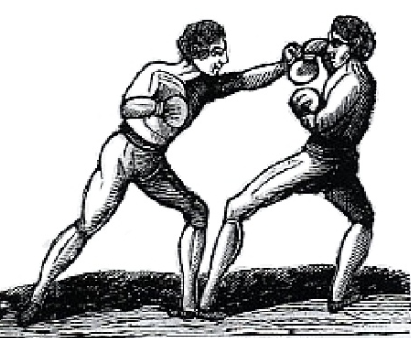Hi Everyone,
Here's an outstanding two-part article written by the very sharp Connor Ruebusch on the late, great Archie Moore and his "Lock" system. I don't remember if I mentioned this in a past post, but back in 1981, I had the honor and privilege of spending a few days being taught and trained by Mr Moore (who came to our gym via his friendship with my coach). I was in high school at the time and not that knowledgeable about who he was. With that, I didn't really appreciate how fortunate I was to spend time with him.
While he shared a lot with me and my teammates, when I look back, I wish I would have picked his brains more. Anyway, it was very cool to hang out and learn from Mr Moore.
Alright, moving on, this article is quite long, and since there's a 10,000 character limit per post, I'll break it up into several parts to accommodate it.
I think many of you here will really enjoy this article. I certainly did. So, sit back, relax, and read on...
Take Care,
Lito
---------------------------------------------------------
Solving Styles: Reverse Engineering Archie Moore and the Lock, part 1
By Connor Ruebusch on Jun 11 2014
There is an old and, frankly, overused saying in combat sports that "styles make fights." Like most cliches, the phrase persists because it contains a universal truth. The same fighter can beat a champion one day and lose to a mere journeyman the next, simply because the journeyman had a style that he didn't quite know how to solve. It is this enigma that makes history's greatest fighters all the more impressive, because they are the ones who solve every opponent put in front of them.
It's rarely an accident, however, that these legends manage to beat all comers. In fact, more often than not, it's the result of intelligent, systematic fighting, which means intelligent, systematic training. Systematic is the key word here; there is a difference, you see, between a system and a style. Whereas "style" denotes the way one likes to fight, "system" denotes the various tools that allow one to do so. A system is all about solving problems that athleticism and personality alone can't crack.
I'll share with you a quote from my mentor Luis Monda that sums it up perfectly.
"When a fighter is trying to hit you, he's asking a question. Your punches are responses. In [a system], there are specific answers to most questions."
In short, styles make fights, but systems solve styles.
In this series I will aim to break down some of history's most iconic systems, as used by their most famous practitioners. Like taking apart a powerful engine, it is my hope that by "reverse engineering" these systems we might gain not only a greater understanding of them, but a greater appreciation for what these fighters accomplished.
In this first installment, we examine Archie Moore's famous cross-armed guard.
What is the Lock?
Let's first examine the most iconic element of Moore's system, the so-called "cross-armed guard" or, as Archie's son Billy Moore terms it, "the Lock." To do that, we'll have to delve into the mists of boxing history.
The exact historical origin of this technique is not easy to suss out, but it's clear that it did not start with Moore. Throughout his career Archie was quick to sing the praises of his trainer, Hiawatha Grey, so perhaps it was he who first taught Moore the technique. This seems likely, given that Grey was a relic of bare-knuckle boxing where, as we'll soon see, this technique has its origins, though it clearly predates even him. Grey's last verified fight took place in 1930, and the cross-armed guard, or at least the barebones concept behind it, is much older than that.
The most notable attribute of Moore's defensive shell, namely the "cross-armed" aspect, is certainly a very old technique. Here a similar maneuver is illustrated in a manual ca. 1825.
The manual refers to this technique as "barring a blow", and it describes a motion wherein the arm is thrown across the spot where an incoming punch is expected to land, to both stop it and carry it off-line, hopefully off-balancing the attacker and even exposing him to counters.
In these days combination punching was not highly emphasized. Boxers were taught to throw their full weight forward into their strikes, making it difficult to follow one committed attack with another (you can see this from the attacker in the example above). As such, defense was comprised mostly of blocks and parries, and pugilists would attempt to pick off each blow as they saw it coming.
By the end of the 19th century, however, boxers were learning that they could bypass the opponent's defenses by throwing two, three, or more punches in quick succession. Feinting was already common practice (this is the reasoning behind the constant "windmilling" of the arms you see in very old fight footage), but by following their first strike with another, and another, early prizefighters found they could land even after one or two successful defenses. Thus, around the turn of the century we begin to see a higher occurrence of "double guards," or covers, such as the high guard still common today, and prototypes of the cross-armed guard used by Moore.
Professor Donovan, The Art of Boxing and Self-Defense, 1902
Here a cross-armed guard is modeled by heavyweight Gus Ruhlin, who fought both Jim Jeffries and Bob Fitzimmons, two of the most important names in boxing history, in the span of one year (losing to both, but there's no shame in that). Professor Donovan, the author of the manual containing this image, advises boxers that such a guard "should be rarely used; and is only really necessary when your opponent brings both hands to play simultaneously or in rapid succession", driving home the point that effective combination punching was still something of a novelty at the time.
Looking at it, it really is a practical guard. Unlike the typical high guard of today, this cross-armed guard places a higher emphasis on stopping straight punches. The right arm, thrown across the face with the hand on the left shoulder, protects the entire jawline as well as the nose and mouth (particularly when the chin is held a bit lower than by Mr. Ruhlin here), leaving only the hard dome of the skull exposed. Also unlike today's high guard, peripheral vision is unimpeded, enhancing one's ability to make active defensive adjustments. The left arm, meanwhile, is placed across the stomach, covering the most vulnerable parts of the torso: the spleen, the liver, and the solar plexus. The last was a primary target in the bare-knuckle days--the straight punch to the solar plexus was such a sought-after blow that this part of the body was referred to by boxers as "the mark"--so it's no surprise that many early guards strove to protect it.
Continued on the next post...
 |
|

 Thanks:
Thanks:  Likes:
Likes:  Dislikes:
Dislikes: 



 Reply With Quote
Reply With Quote
Bookmarks